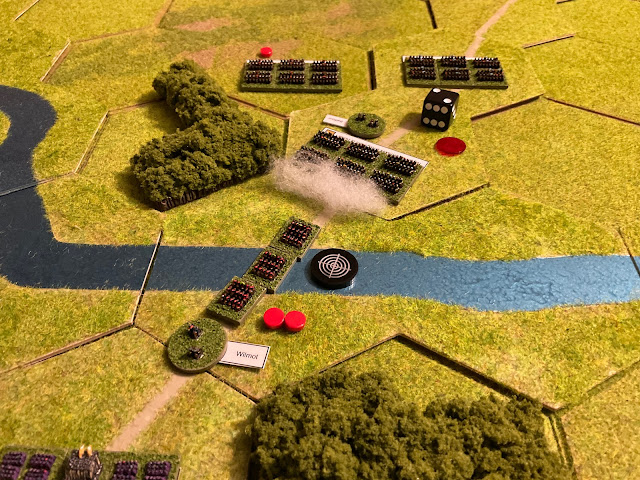So in part 1 we were left with the Royalists leading 5 victory points to 2, and both sides needing 8 for an immediate win.
The only way Parliament could get the extra points after occupying the castle was to cross the river under fire and attempt to kill off more of Hopton’s forces.
As you may remember, that didn’t turn out to well earlier.
Essex ordered his men to hold and even pull back while he thought the matter through. Time was not on his side, there being only three turns left in the game, and up to this point the brigade activations had been perversely favouring Hopton.
Fortunately for Essex, his adversary decided to help out.
First up was Wilmot who thought he’d have another go at crossing the ford on the Royalist left. The reaction from the enemy horse on the other bank was devastating and Wilmot got away by the skin of his teeth - with a handful of survivors. Essex scored a point for this rash intervention.
Hopton’s plan of occupying the castle, (abandoned early on) seemed possible again now that wall had been breached. Orders were issued to seize the place and Colonel Paulet’s brigade hastened to obey.
In the time between receiving the order and making any progress to execute it Paulet had been held up by two cavalry attacks across the bridge and the news that Ballard and a battalia of enemy Foote had got in there before him.
Still…orders were orders…and they did have a secret weapon up their sleeve.
Taking advantage of a lull in the fighting Paulet and his lads marched onto the bridge unopposed and saw the way to the fortress gates were unimpeded.
The next activation was Parliamentary and Essex had no choice but to send his remaining horse regiment on that flank to charge Paulet’s infantry while still in a vulnerable column.
The outcome wouldn’t have been a good one for the Royalists but even as the horse began to move Paulet used his « Gadzooks » burn card - stopping the enemy in their tracks and allowing him to reactivate his brigade.
Shrugging off desultory fire from the castle walls Paulet’s men made their way around to the breach and the first storming parties went in - safe in the knowledge that reinforcements were crossing the bridge behind them.
Against the odds the storm was a success and Ballard and his Parliamentary troops made a rapid exit through a rear postern gate with only minimal losses.
Paulet gave orders to man the walls and begin filling the breach, the better to defend themselves. Suddenly the scores had shifted dramatically. Parliament had just lost the 2 victory points for occupying the castle and the Royalists had gained them. The scores now stood at 7 to 1.
With but two turns left, a crushing defeat for Essex seemed inevitable.
And then things changed.
Rapidly.
Regaining the initiative Ballard’s brigade surrounded the castle and staged a storm of their own. Despite the benefit of its stone defences the now defending Royalists took casualties and worst of all their heroic leader Paulet was slain by a shot through his manly breast (he actually fell down the castle stairs clutching a bottle of sack and broke his neck, but hey, details).
Worse was to come for on the very last turn, Ballard’s brigade re occupied the castle and destroyed the Royalist reinforcements struggling to get off the bridge. The scores swung dramatically the other way. Essex now had 2 points for the castle, 2 points for the destruction of 2 Royalist foot battalia 1 point for killing of Wilmots regiment of horse and 1 point for killing Colonel Paulet. Hopton had 3 points for breaching the castle walls and 2 points for routing the Parliamentary horse earlier.
Turn 12 ended and the game was over. Neither side had reached 8 points during it for an immediate win but Essex with 6 victory points to Hopton’s 5 was quick to send letters to London proclaiming his triumph.
With the light fading Hopton’s army conceded the field and made camp three miles south.
Right oh - were back to the strategic map next. Parliament has six points to spend on it followed by the Royalists three. Both sides will also get a number of guaranteed settlements joining their cause this turn in Cornwall / Wales and in East Anglia / Lincolnshire.
Observations on the battle.
Both sides had the flank order option allowing them to send a brigade off board only to reappear later on the other side of the river. Neither took it. It might have prevented the necessity of the opposed river crossing shambles that actually occurred.
Hopton was able to score 1 point for each hit on the enemy castle walls. He could have just stayed put and chanced his arm on inflicting more hits after causing the breach - though this was not guaranteed of course. He could have brought more guns with him too, though to be fair he didn’t know beforehand that his army would be engaged in a siege.
Both sides stuck to having three brigade commanders but could have had up to 5 if they’d chosen a different force mix. A small brigade of say 2 Foote with an order to flank march at the outset may have been decisive.
Toodleooh.





















